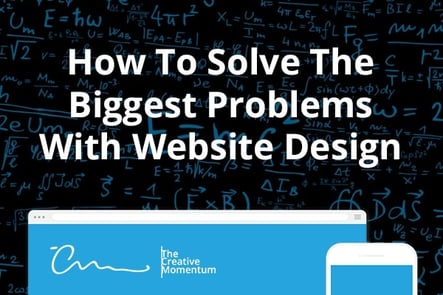
If you want a website that attracts visitors and boosts conversion rates, you can't afford to have a poorly implemented website design. One of the biggest factors that separate great sites from average or poorly designed ones is user experience (UX). Visitors want to be able to read about your product, find your contact information, and navigate your website with ease; if they can’t, your sales are probably going to drop.
Fixing Your Mistakes through Website Design
The good news about UX is that it's typically easy to implement, so you don't have to worry about giving your website a dramatic facelift to correct those pesky marketing flaws.
Here are some common problems that you might face when promoting your product, as well as some solutions that utilize website design.
1. Visitors don’t know about your product
Having hidden or out-of-the-way information about your services can cost you a lot of conversions. Also, you don’t want your customers to make guesses about how to reach you or what you’re providing. Fortunately, you can fix this by putting all of your information in easy-to-find spots on your website, like the center of the page. Just be sure to accurately describe what you’re offering and how your services are different than your competitors, and don’t put important information in sidebars and annoying pop-ups.
2. Nobody is contacting you
Do you have in incredible product and an SEO-optimized website and still, nobody is reaching out to you? It may be that you need to make some minor adjustments to your website design so that your contact details are in a visible spot. Don't just put your email address up, add your Facebook, Instagram, and Twitter accounts as well.
Most customers don’t only enjoy engaging with businesses on social media platforms, they also expect it. Make your contact details visible and start interacting with your clients and prospects.
3. Your website isn’t getting any hits
If you’ve been following good inbound marketing strategy and have even started a Google PPC campaign, and your website still isn't getting any action. Before you change your marketing strategy, take a look at your website design and see if there's anything that could be fixed.
Is your site mobile responsive? If not then you can forget about having a good SEO ranking, or many mobile visitors for that matter. Look at your site’s loading times as well. If it’s a flashy webpage that has to load double-digit JavaScript libraries, it probably takes a long time to load on mobile devices, older desktops, and functional laptops.
Nobody wants to sit by and wait for a website to load, regardless of how awesome your aesthetics are. Try simplifying your website’s layout and making it compatible with Google AMP and you’ll probably notice an increase in traffic.
Your Web Design Matters
Many people overlook the importance of having an ergonomically designed website and go straight for good looks. Most visitors want UX over flashy website design, any day of the week. Increase your leads and conversions by tweaking your website to give them what they want.
The good news about UX is that it's typically easy to implement, so you don't have to worry about giving your site a dramatic facelift to correct those pesky marketing flaws.
Here are some common problems that you might face when promoting your product, as well as some solutions that utilize website design.
1. Visitors don’t know about your product
Having hidden or out-of-the-way information about your services can cost you a lot of conversions. Also, you don’t want your customers to make guesses about how to reach you or what you’re providing. Fortunately, you can fix this by putting all of your information in easy-to-find spots on your website, like the center of the page. Just be sure to accurately describe what you’re offering and how your services are different than your competitors, and don’t put important information in sidebars and annoying pop-ups.
2. Nobody is contacting you
Do you have in incredible product and an SEO-optimized website and still, nobody is reaching out to you? It may be that you need to make some minor adjustments to your website design so that your contact details are in a visible spot. Don't just put your email address up, add your Facebook, Instagram, and Twitter accounts as well.
Most customers don’t only enjoy engaging with businesses on social media platforms, they also expect it. Make your contact details visible and start interacting with your clients and prospects.
3. Your site isn’t getting any hits
If you’ve been following good inbound marketing strategy and have even started a Google PPC campaign, and your website still isn't getting any action. Before you change your marketing strategy, take a look at your website design and see if there's anything that could be fixed.
Is your site mobile responsive? If not then you can forget about having a good SEO ranking, or many mobile visitors for that matter. Look at your site’s loading times as well. If it’s a flashy webpage that has to load double-digit JavaScript libraries, it probably takes a long time to load on mobile devices, older desktops, and functional laptops.
Nobody wants to sit by and wait for a website to load, regardless of how awesome your aesthetics are. Try simplifying your website’s layout and making it compatible with Google AMP and you’ll probably notice an increase in traffic.
Your Web Design Matters
Many people overlook the importance of having an ergonomically designed website and go straight for good looks. Most visitors want UX over flashy website design, any day of the week. Increase your leads and conversions by tweaking your website to give them what they want.


